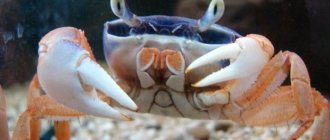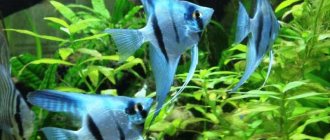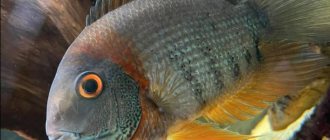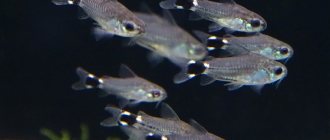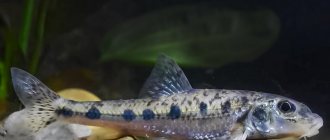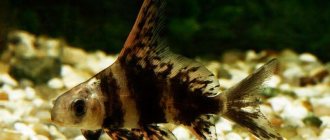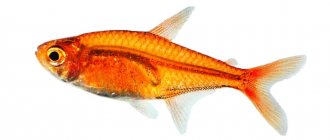Types of fish
| Rainbow shining | |
| Save Status | |
| Least Concern (IUCN 3.1) [1] | |
| Scientific classification | |
| Kingdom: | Animalia |
| Type: | Chordata |
| Class: | Actinopterygia |
| Order: | Carp-like |
| Family: | Leuciscidae |
| Subfamily: | Pogonichthyinae |
| Genus: | Notropis |
| Variety: | N. chrosomus |
| Binomial name | |
| Notropis chromosomalus (Jordan, 1877) | |
| Synonyms | |
| Hybopsis chrosomus Jordan, 1877 | |
Rainbow black eye
(
Notropis chrosomus
) is a North American species of ray-finned fish in the genus
Notropis
.
The rainbow black eye ranges in length from 5 to 8 centimeters. It is translucent pink to golden in color with a silver-black stripe on the sides. The base of the fins is reddish in color. Adult males change color during mating. Their pelvic fins turn blue, their head turns purple, and their nose turns red.
The rainbow lanternfly was originally endemic to the Mobile River system, where it can be found in the small, clear rivers of the Alabama, Coosa, and Black Warrior River drainage basins, among others. It now also appears in some Tennessee rivers and is a popular pet for aquariums and ponds.
Rainbow Shiners spawn from May to June.
Introduction [edit]
This species of fish is commonly found in small streams along the river basins of Northwest Georgia, Northeast Alabama, and, as recent research shows, southwest Tennessee. N. chrosomus
is a freshwater benthopelagic fish that inhabits riffles and gravel-bottomed pools in streams and small rivers, and is usually found together with representatives of the genus
Campostoma
.
They are primarily insectivores, and although research suggests that the predominant prey of N. chrosomus
comes from the family
Chironomidae
, they are found to be more opportunistic feeders and not very selective.
The maximum age is usually two years for both sexes, and sexual maturity occurs at one year of age. N. chrosomus
increase food intake in late winter and the spring months before spawning to meet the increased energy requirements for gamete production and sexual reproduction.
Hybridization has been observed between N. baileyi
and
N. chrosomus
in areas where
N. chilitious
populations introduced .
Limited information is available regarding current and past treatment of N. chrosomus
.
What is known is that the species was once endemic to parts of northern Alabama, and in recent decades populations have spread further north into Tennessee. The northward latitudinal movement may be of particular interest to researchers because N. chrosomus
prefers warmer waters.
Breeding/reproduction
Sexual maturity is reached at 12 months. Due to their short lifespan, fish have no more than two breeding seasons. In nature, spawning occurs in the warm season. Accordingly, a change in water temperature can serve as a stimulus for reproduction. For example, if the fish are kept in the recommended range of 16–20 °C, then a gradual increase to 25 °C will start the process. The breeding strategy is typical for most cyprinids. Females release eggs in the water column, and males fertilize them. The eggs are carried away by the current, sinking to the bottom and rolling into the spaces between the stones, which become the only protection for future Notropis iridescent. Parental instincts are not developed, so if given the opportunity, adult fish will definitely eat their own offspring. The incubation period lasts 5–6 days. The fry remain in place for another 1–2 days, feeding on the remains of the yolk sac. A week after spawning, the emerging juveniles begin to swim freely.
Geographical distribution[edit]
The rainbow aurora's native range consists of the Mobile Bay basin, including the Coosa, Cahaba and Alabama river basins. This species is known from and may have been introduced to the Black Warrior River system. These reports, however, have recently been questioned based on the fact that the species is commonly found in streams with limestone outcrops in the watershed. N. chrosomus occurs on the southeastern edge of the Black Warrior River system, which consists of streams that have headwaters in limestone formations. [2] N. chrosomus is also known and may have been introduced into tributaries of the Tennessee River, including Town Creek in northern Alabama and the South Chickamauga Creek system in northern Georgia. The means of their introduction is unknown, but it is believed that it was by releasing a bucket of bait. [3]
Ecology [edit]
Notropis chrosomus is typically found in small, low-turbidity headwater streams flowing over gravel and sand riffles and pools, but is also found in springs and small clear streams. N. chrosomus inhabits freshwater benthopelagic habitats in temperate waters. [4]Rainbow fireflies are typically found in association with Fundulus stellifer (also thought to have been introduced by recent accidental introductions of bait buckets) in small streams. N. chrosomus are considered opportunistic insectivores. More than 80% of the food they eat is invertebrates, mainly aquatic and terrestrial insects. Research indicates that the gut contents are primarily composed of Chironomidae larvae, unidentified insect parts, unidentified adult dipterans, and springtails. Notropis chrosomus is considered a disturbance-sensitive species, but its occurrence rate in the upper Cahaba River (an area recently threatened by urban development and habitat disturbance) has nearly doubled. The population increased from 6.5% in 1983 to 12.5% in 1995, in contrast to other disturbance-sensitive species also found in the upper Cahaba River, such as Cyprinella callistia, Etheostoma jordani, and Percina brevicauda, whose populations decreased significantly over the same period of time.[5]
Habitat
Comes from North America from the southeastern United States (Tennessee, Alabama, Georgia).
Inhabits small streams and rivers with clear blue water. This shade is associated with high mineralization, since the sources of the rivers are in limestone deposits. Substrates consist of stones, boulders, coarse sand, and pebbles. Aquatic vegetation is represented mainly by coastal plants. Brief information:
- Aquarium volume - from 250 l.
- Temperature - 16–25°C
- pH value – 6.5–7.7
- Water hardness - 5–18 dGH
- Substrate type - rocky
- Lighting - moderate, bright
- Brackish water - no
- Water movement - moderate, strong
- The size of the fish is 6–8 cm.
- Food - any food
- Temperament - peaceful
- Keeping - gregarious in numbers of 8–10 individuals
Life story [edit]
On average, adults reach 1.6 to 2.4 inches in length. The growth rate of N. chrosomus increases in spring in both length and weight in individuals one or two years old. The average age in months varies between genders. Men live on average 11.7 months, and women - 13.5 months. The maximum age for men is about 23 months and for women 25 months. Puberty usually occurs by 12 months of age for most people, with the exception of a few who become sexually mature by 24 months of age. The maximum age is just over 24 months and sexual maturity occurs in most individuals by 12 months of age, suggesting no more than two spawning seasons for each individual. Spawning occurs in water with a temperature of 16-25 °C in late spring/early summer. [6]N. chrosomus spawns in habits similar to those used throughout the year, but oviposition usually occurs in Semotilus sp. nests and Nocomis sp. nests [7] Rainbow fireflies increase their food intake in late winter and early spring, which coincides with the increased growth seen in the spring months before the spawning season and also precedes the increased energy demands of gamete production and courtship. [8]
Maintenance and care, arrangement of the aquarium
The optimal size of an aquarium for a flock of 10 fish starts from 250 liters. The design is simple and may well consist solely of rocky substrate. The remaining decorative elements are selected at the discretion of the aquarist. The only important condition is the presence of large space for swimming. For successful long-term maintenance of Notropis iridescent, you will need to provide a stable aquatic environment similar to that in which fish live in nature - clean, transparent water, rich in oxygen, with medium to high pH and dGH values. The accumulation of organic waste, which can change the hydrochemical composition and disrupt the normal course of the nitrogen cycle, should not be allowed. For this purpose, regular procedures for maintaining and cleaning the aquarium are carried out and the necessary equipment is installed, primarily a filtration system. This is a cold-water species. The water temperature should approximately correspond to the season. From autumn to spring it is 16–20°C, and in summer it rises to 25°C. The hydrochemical composition has medium and high pH and dGH values. Since fish are prone to jumping, it is necessary to provide a safe cover with a non-traumatic inner surface and insulated lamps. They jump mainly at night; if you install night lighting, this can also solve the problem.
Current management[edit]
N. chrosomus is currently classified as a species of relatively little conservation concern and does not require significant additional protection or management, monitoring or research activities. [9] However, a detailed restoration plan for the Mobile River Basin aquatic ecosystem that supports N. chrosomus is under development. The plan was developed by the U.S. Fish and Wildlife Service and aims to protect the basin's native aquatic fauna and flora through management of aquatic ecosystems. Declines in many other aquatic species in the basin are the result of increasing human populations, modifications to meet their needs, and the effects of current land use. The population of the basin and its associated needs for housing, recreation, and agricultural products are projected to grow within the basin. Thus, the restoration plan seeks to emphasize the stewardship responsibility shared by all basin residents by promoting three core principles: 1. Use, to the maximum extent practicable, existing laws, regulations, and policies to protect listed populations and develop a stream management strategy , which provides for: high priority of conservation and restoration. 2.Encourage voluntary management through participatory initiatives and individual action as the only practical and cost-effective means of minimizing the adverse impacts of private land use and watershed activities. 3. Continue to promote research efforts on the life history, sensitivities, and needs of threatened aquatic species, and to develop technological capabilities for their conservation and propagation. In an effort to improve basin habitat conditions, it is likely that N. chrosomus populations will continue to be stable or increase with these improvements. In an effort to improve basin habitat conditions, it is likely that N. chrosomus populations will continue to be stable or increase with these improvements. In an effort to improve habitat conditions in the basin, it is likely that N. chrosomus populations will continue to remain stable or increase with these improvements.[10]
NOTROPIS RAINBOW (Notropis chrosomus)
FSB
0
5 362
Share
Notropis rainbow, or as this fish is also called “Rainbow Radiance”, naturally lives in the waters of North America. Fish can be found in rivers and small streams with crystal clear water. The water in these places has a bluish tint, which is associated with increased mineralization, since the river beds pass through limestone deposits. The bottom of reservoirs is a mixture of sand, stones and pebbles. There are practically no plants on the bottom; all aquatic vegetation is represented only along the shores.
Rainbow Radiance fish first appeared on the European market in 2009 and have since become very popular among aquarists. Due to the ease of keeping these fish, they can be recommended to beginner aquarists.
Notropis chrosomus have a very attractive coloration with a neon shine. The body of the fish is pink with bluish specks and stripes. Blue pigmentation is also present on the fins of the fish. Sex differences are not pronounced. In nature, the size of fish reaches 8 cm, while in an aquarium their length usually does not exceed 6 cm.
Rainbow notropis are peace-loving fish leading a schooling lifestyle. They need to be kept in an aquarium in a group of at least 10 individuals. For such a number of fish, the aquarium must have a volume of at least 250 liters. It is possible to keep them in a common aquarium with other peace-loving fish of comparable size that lead an active lifestyle.
Water parameters: temperature 16–25°C (autumn-spring 16-20°C, summer up to 25°C), hardness dH 4-20°, acidity pH 6.5-7.5. Filtration, strong aeration and weekly replacement of 1/3 of the aquarium water with fresh water are required. It is advisable to create a small flow of water in the aquarium. These fish often jump out of the water, so the aquarium must be covered with a lid.
A mixture of coarse sand and gravel can be used as a substrate. You need to place large stones at the bottom, but at the same time make sure there is free space for swimming.
Medium intensity lighting, lasting about 10 hours a day.
Under natural conditions, rainbow notropis feeds on small insects and their larvae, invertebrates and crustaceans. In aquarium conditions, fish are fed with any live and frozen foods: daphnia, brine shrimp, bloodworms, etc.
Reproduction
Notropis iridescent reaches its sexual maturity by the age of one year.
In nature, fish spawning occurs in the summer. The stimulus for the start of spawning is an increase in water temperature by several degrees relative to that at which the fish constantly live in the aquarium, but not higher than 25°C.
During the spawning process, females randomly spawn eggs in the water column, and males immediately fertilize the eggs. Sinking to the bottom, the caviar rolls into all the spaces between the stones, which serve as protection from the encroachments of producers who are ready to feast on it at any moment.
The eggs are incubated for 5-6 days. The newly hatched fry are inactive for 1-2 days and feed on nutrients contained in their yolk sac. After this time, the fry begin to swim and feed.
The fry are fed live dust, and after 1.5-2 weeks they begin to give artemia.
The lifespan of rainbow notropis in aquarium conditions is about 2 years.
Tags rainbow notropis, notropis chrosomus
Found an error or a dead link?
Select the problematic fragment with the mouse and press CTRL+ENTER. In the window that appears, describe the problem and send it to the resource Administration.
Links[edit]
- NatureServe (2016). "Notropis chrosomus". IUCN Red List of Threatened Species
.
2016
. Retrieved April 14, 2021.CS1 maint: ref=harv (link) URL of old form - Fishes of Alabama and Mobile Basin 2013. Notropis chrosomus. "Archival copy". Archived from the original on 2014-02-06. Retrieved November 24, 2013.CS1 maint: archived copy as title (link)
- ↑
Leo Niko. 2010. Notropis chrosomus. USGS Non-Native Aquatic Species Database, Gainesville, FL. < Https://nas.er.usgs.gov/queries/FactSheet.asp?speciesID=592 > Revision date: 12/05/2003. - Froese, Rainer 2013. Notropis chrosomus. https://www.fishbase.org/summary/2848
- Onorato, D. R. Angus, and C. R. Marion. 2000. Historical changes in fish faunal assemblages of the upper Cahaba River in Alabama associated with extensive urban development in the watershed. Journal of Freshwater Ecology 15: 7-63.
- Holder, DS and SL Authority. 2010. Aspects of the life cycle of the rainbow radiant Notropis chrosomus (Teleostei: Cyprinidae) in northern Georgia. Southeastern Naturalist 9: 347-358.
- Bart, H. L., M. F. Cashner, and K. R. Piller. 2011. Phylogenetic relationships of the North American carp subgenus hydropholax. Molecular Phylogenetics and Evolution 59: 725–735.
- Johnston, C. E. and K. J. Kleiner. 1994. Reproductive behavior of rainbow bluehead ("Notropis chrosomus") and rough bluehead ("Notropis baileye"), nesting companions of bluehead chub ("Nocomis leplocephalus") (Pisces: Cyprinidae) in the Alabama River drainage system. Journal of the Alabama Academy of Sciences 65: 230-238.
- NatureServe 2013. Notropis chrosomus. In: IUCN 2013. IUCN Red List of Threatened Species. Version 2013.2. .
- US Fish and Wildlife Service and Mobile River Basin Coalition Planning Committee, comp. Restoration plan for the aquatic ecosystem of a mobile river basin. Np Representative: np, nd www.fws.gov. Internet.
- Robert Jay Goldstein, Rodney W. Harper, Richard Edwards: American Aquarium Fishes
.
Texas A&M University Press 2000, ISBN 978-0-89096-880-2, page 109 ( limited copy online
, page 109, at Google Books) - Leo Niko. 2010. Notropis chrosomus. USGS Non-Native Aquatic Species Database, Gainesville, FL. < Https://nas.er.usgs.gov/queries/FactSheet.asp?speciesID=592 > Revision date: 12/05/2003
- Barth, H.L., M.F. Cashner and K.R. Piller. 2011. Phylogenetic relationships of the North American carp subgenus hydropholax
. Molecular Phylogenetics and Evolution 59: 725–735. - Holder, DS and SL Powers. 2010. Life-historical aspects of the rainbow cleaner
,
Notropis chrosomus
(teleost: cyprinid), in northern Georgia. Southeastern Naturalist 9: 347-358. - Johnston, C. E. and K. J. Kleiner. 1994. Reproductive behavior of rainbow chub (Notropis chrosomus) and rough bluehead (Notropis baileye), nesting companions of bluehead chub (Nocomis leplocephalus) (Pisces: Cyprinidae) in the Alabama River drainage system.
Journal of the Alabama Academy of Sciences 65: 230-238. - Olson, Adric Delray. 2012. Features of the life activity of the specular luster "Notropis Spectrunculus"
in western North Carolina. Doctoral dissertation, Western Carolina University. - Onorato D., Angus R.A. and Marion K.R. 2000. Historical changes in fish faunal assemblages of the upper Cahaba River in Alabama associated with extensive urban development in the watershed
. Journal of Freshwater Ecology 15: 7-63. - NatureServe 2013. Notropis chrosomus. In: IUCN 2013. IUCN Red List of Threatened Species. Version 2013.2. .
- Froese, Rainer 2013. Notropis chrosomus. https://www.fishbase.org/summary/2848
- Fishes of Alabama and Mobile Basin 2013. Notropis chrosomus. https://web.archive.org/web/20140206222049/https://www.outdooralabama.com/fishing/freshwater/fish/other/minnow/shiner/rainbow/
- US Fish and Wildlife Service and Mobile River Basin Coalition Planning Committee, comp. Restoration plan for the aquatic ecosystem of a mobile river basin. Np Representative: np, nd www.fws.gov. Internet.
External links [edit]
- Rainbow black eye - image on the Samford University website
- Eric Brodock: Rainbow Shinher - article in Finformation
(Volume 62, Issue 2), magazine
of the Greater Pittsburgh Aquarium Society. - Notropis chrosomus - Video on YouTube
| Taxon identifiers |
|

